Nintendo Switch 2 vs Asus ROG Ally
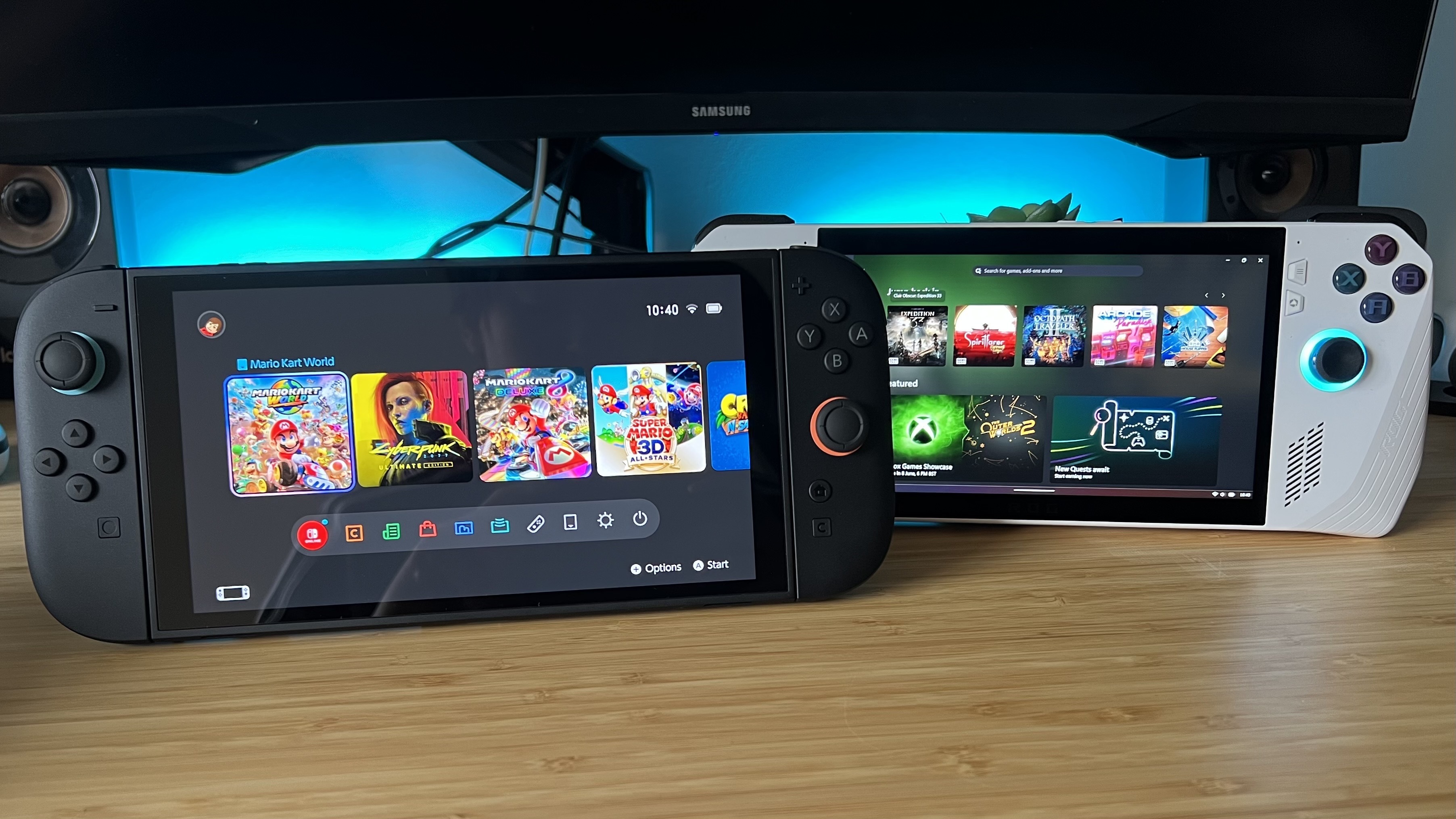
The Nintendo Switch 2 is here and the battle of the handheld giants just got a little more heated. With docked gameplay reaching 4K resolutions, a slate of much heavier releases on the way, and a larger display up top, Nintendo's new device could well give portable PCs something to think about.
The world of the best gaming handhelds has been dominated by two models for the last few years. We've already seen how the Nintendo Switch 2 vs Steam Deck battle plays out, so I'm turning my attention to the best handheld PC on the market; the Asus ROG Ally.
I first reviewed the ROG Ally back in 2023, and then took on the Asus ROG Ally X just a year later. With their AMD Ryzen Z1E chips, full-sized controls, and chunkier form factor, they both offer a very different experience to Ninty's family-friendly console. Now that I've got the Nintendo Switch 2 firmly in my hands, I'm pitting it against the very system that saw its predecessor collecting dust on my shelf.
Combining handheld freedom with the power of an Xbox, the ROG Xbox Ally is a game changer. Boot up directly into the immersive Xbox full screen experience, purpose-built for gaming.
TL;DR: Asus ROG Ally vs Nintendo Switch 2
Asus ROG Ally
- Higher MSRP
- Regularly on sale
- Larger, chunky design
- Heavier
- Better comfort
- Full-sized controls
- Smaller screen
- Larger battery
- No inbuilt mouse
- Fixed controls
- One USB-C (unless on Ally X)
- Larger variety of games
- 4K gameplay is hit and miss
- 512GB internal storage
Nintendo Switch 2
- Lower MSRP
- Unlikely to drop price soon
- Slimmer form factor
- Lighter
- Less ergonomic
- Smaller controls
- Larger display
- Smaller battery
- Mouse sensor on Joy-Con
- Detachable controls
- Two USB-C
- Nintendo exclusives
- Games optimized 4K (docked)
- 256GB internal storage
Price
| Header Cell - Column 0 | Nintendo Switch 2 | Asus ROG Ally Z1E | Asus ROG Ally X |
|---|---|---|---|
MSRP | $449.99 / £395.99 | $649.99 / £599.99 | $799.99 / £799.99 |
Record-low | $449.99 / £395.99 | $449.99 / £399.99 | $699.99 / £799.99 |
There's a considerable jump in price between the Nintendo Switch 2 and the Asus ROG Ally (and then again up to the X model), however there's a little more nuance to these numbers as well. The Asus ROG Ally Z1E is no stranger to sales, and it's dropped to $449.99 / £399.99 a few times in the last year. That's the same rate as the Switch 2 at launch (a set of numbers I don't expect to be falling any time soon).
If timed correctly, the Asus ROG Ally could be the same price as the Nintendo Switch 2 - though discounts are far less forgiving on the boosted X model. That's a $700 device even on sale and I haven't seen any price cuts in the UK at the time of writing. That price increase does come with sturdier specs and a slightly better design, but it's only going to make sense for a select number of players.
There's also a cheaper version of the Asus ROG Ally, with a Z1 rather than Z1E chipset. However, it's harder to find on the shelves these days and seems to be fading into the sunset now. If you do spot it, though, it's usually sitting at around $399.99 when on sale.
At full price, the Nintendo Switch 2 takes this one. It's $200 / £200 cheaper than the Asus ROG Ally Z1E, but it's well worth looking out for discounts on the latter.
Weekly digests, tales from the communities you love, and more
Winner: Nintendo Switch 2
Portability
| Header Cell - Column 0 | Nintendo Switch 2 | Asus ROG Ally Z1E | Asus ROG Ally X |
|---|---|---|---|
Dimensions | 4.5 x 10.7 x 0.55 inch | 4.37 x 11.02 x 1.28 inch | 4.37 x 11.02 x 1.45 inch |
Weight | 1.18lbs (535g) | 1.34lbs (608g) | 1.49lbs (678g) |
These are handhelds, so they need to be easily portable. Of the bunch, the Nintendo Switch 2 is the lightest and thinnest, measuring in at only 0.55-inches thick and weighing 535g. The Asus ROG Ally Z1E is considerably bulkier, and the Ally X slightly more so, at 1.28-inches and 1.45-inches respectively.
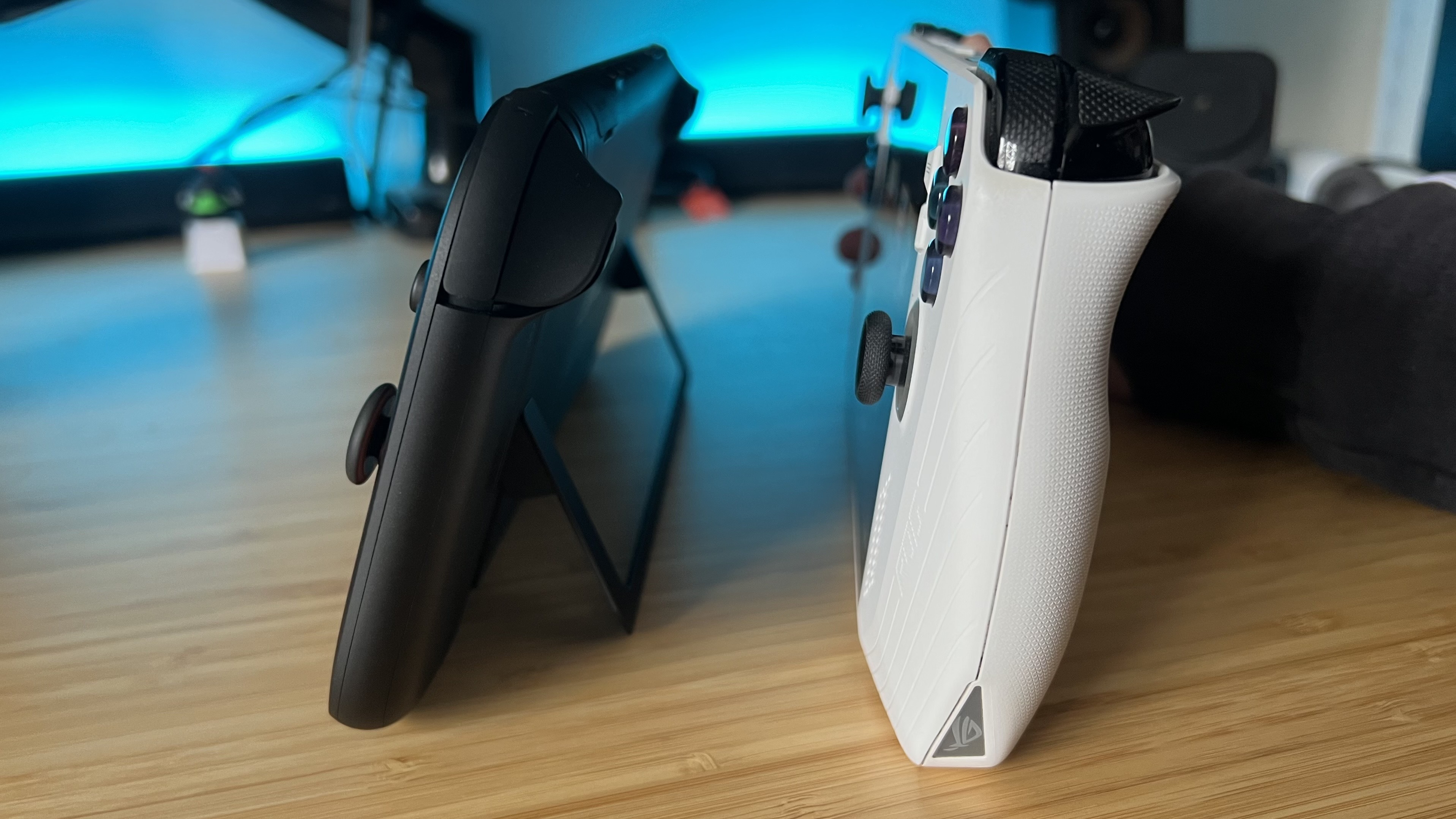
That means your case is going to be significantly larger if you opt for the Asus ROG Ally. I've been transporting both, and it's much easier to squeeze Ninty's system into a backpack. Even a slimline fabric ROG Ally case is still bulky and heavy, whereas I can slip skinny Switch clamshell into even a smaller bag and still have space left over.
Winner: Nintendo Switch 2
Comfort
Nintendo Switch 2 | Asus ROG Ally Z1E | Asus ROG Ally X |
|---|---|---|
Thinner controllers | Chunkier controllers with grips | Chunkier controllers with larger grips |
Asymmetrical thumbsticks | Asymmetrical thumbsticks | Asymmetrical thumbsticks |
Matte surface | Textured surface | Textured surface |
The Nintendo Switch 2 is certainly far more comfortable than its predecessor, but it still sacrifices the extra grips of the Asus ROG Ally in favor of a slimmer form factor. That means it's lighter and easier on the wrists overall, but with smaller controls and less to hold onto I do still feel a slight cramp after longer play sessions.
This year's Joy-Con are taller, but they're not much wider. Pair that with the scaled-down face buttons and thumbsticks, compared to the full-sized iterations on the Ally, and larger hands will still struggle to stay relaxed during marathon runs.
The Asus ROG Ally is built more for ergonomic comfort than the Switch 2. It features large protruding grips around the rear that provide additional leverage and promote a more natural hand placement. These grips are coated with a textured surface for a more precise hold, whereas Nintendo's device is completely matte. One isn't necessarily better than the other, this is largely down to personal preference. I much prefer the softer feel of the Switch 2 compared to the original console, but it can feel a little slippery compared to the rougher surface of the Ally.
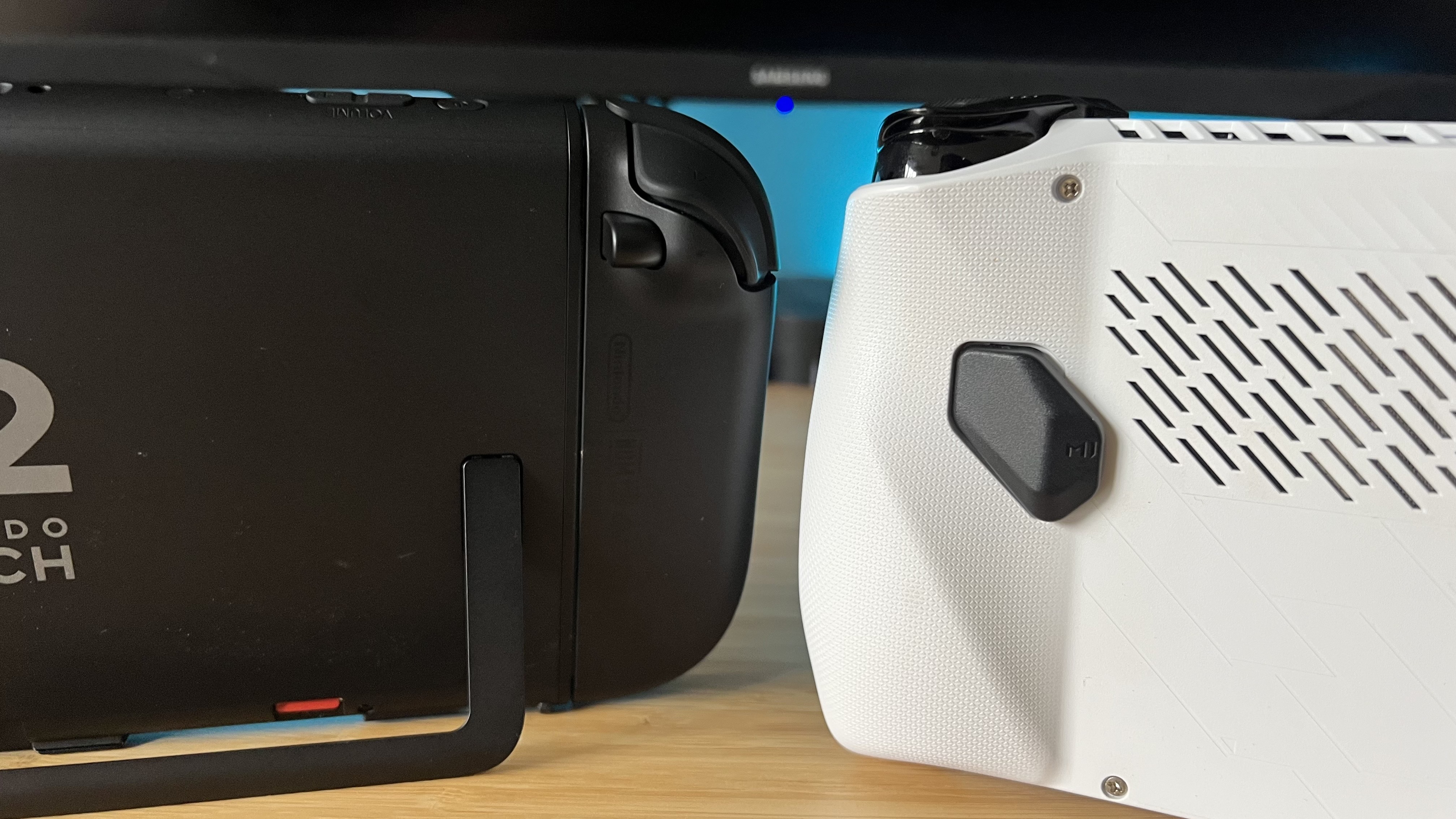
The slanted edges around the front are also more gentle on the palms compared to the completely flat Joy-Con 2. I still find the corners of Nintendo's controllers can dig into my hands after a bit, whereas I've never experienced the issue on the Ally.
Nintendo wins in weight. If you're holding the device in the air, rather than resting it on your lap or a table, the additional heft of Asus's handheld does make itself known. Overall, however, this one goes to the PC.
Winner: Asus ROG Ally
Display
Nintendo Switch 2 | Asus ROG Ally Z1E | Asus ROG Ally X |
|---|---|---|
7.9-inch | 7-inch | 7-inch |
LCD | LCD | LCD |
1920 x 1080 (up to 4K docked) | 1920 x 1080 (up to 4K with dock) | 1920 x 1080 (up to 4K with dock) |
120Hz (60Hz at 4K when docked) | 120Hz (60Hz at 4K when docked) | 120Hz (60Hz at 4K when docked) |
HDR10 | No HDR | No HDR |
400 nits | 500 nits | 500 nits |
On paper, the Nintendo Switch 2 and the Asus ROG Ally have very similar displays. They're both 1080p LCDs running at 120Hz, though there's a 0.9-inch size difference. Overall, Ninty's pulled this one off particularly well.
The Switch 2's panel isn't as bight as the Ally's 500 nits, but it does come with HDR support. Asus's display is crisp, sharp, and has excellent range, but side by side there's a little more pop in Nintendo's display (notably more so in games like Cyberpunk 2077 with HDR switched off) - even if the Asus is a little sharper on occasion.
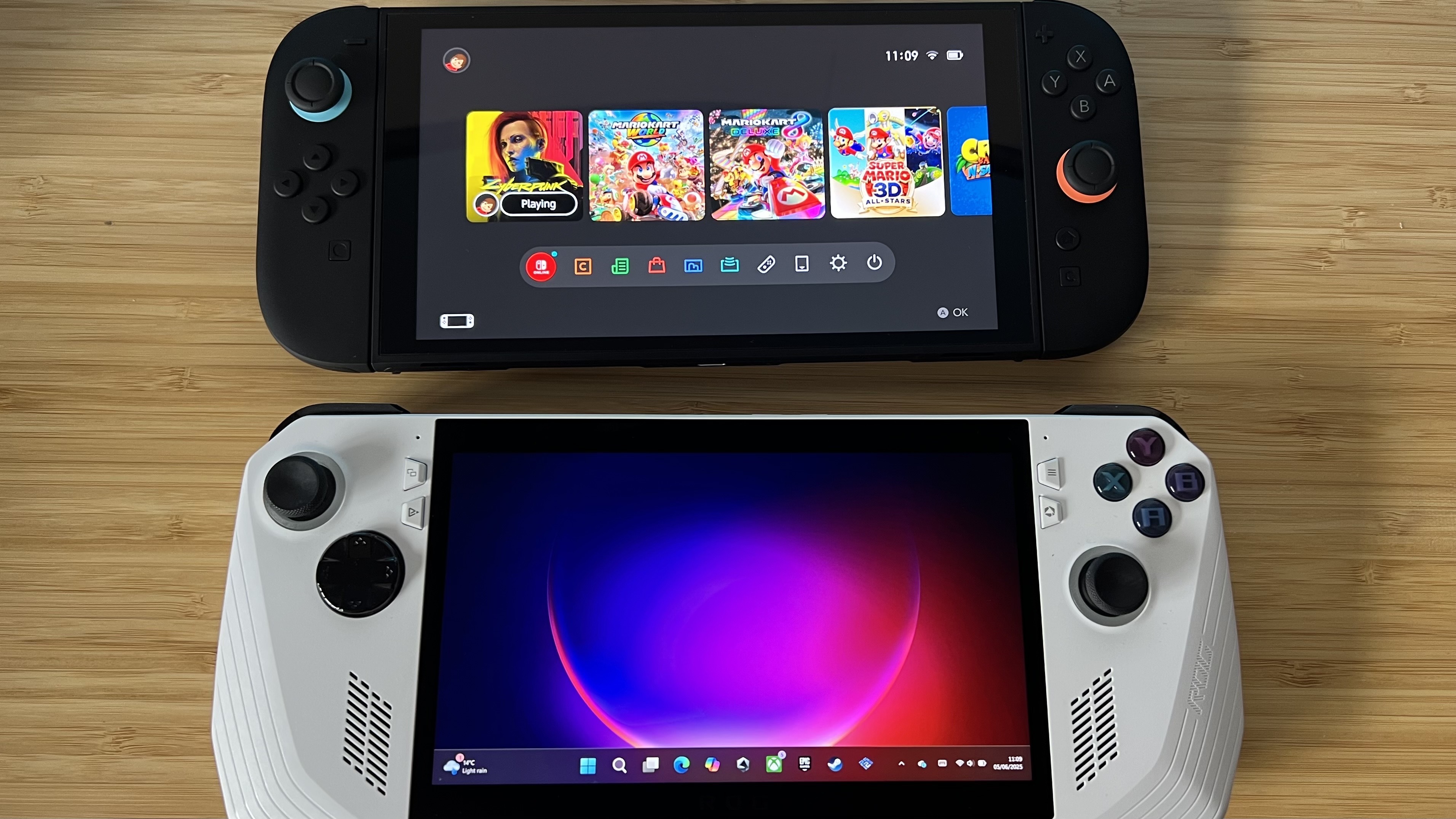
Despite only hitting the shelves a couple of years ago, Asus's device suffers from fairly large bezels around the display itself. It's a factor that can make the Ally feel a little outdated and, while the Switch 2 still keeps similar bezels in play, the larger panel makes it a little easier to forgive.
It should also be noted, and I'll get into this more later in the Performance section, that both the Nintendo Switch 2 and the Asus ROG Ally can output at 4K 60Hz when connected to a compatible display. The difference is the Ally is a PC and the Switch will have games specifically optimized for this level of resolution. You'll have a much easier time getting your games looking good on a 4K gaming monitor with the Nintendo Switch 2 to hand.
Winner: Nintendo Switch 2
Battery
Nintendo Switch 2 | Asus ROG Ally Z1E | Asus ROG Ally X |
|---|---|---|
19.3WHrs (5,220mAh at 3.7v) | 40WHrs | 80WHrs |
2 - 6.5 hours runtime | 1 - 6 hours runtime | 3 - 8.5 hours runtime |
It's undeniable that the Nintendo Switch 2 has a weaker battery than the Asus ROG Ally (and a much smaller one compared to the X). That's not the full story, though. Yes, at 5,220mAh (and running at 3.7v), you're not even getting half the WHr size of the Ally in the Switch 2 - and yet the device's actual runtime easily keeps up.
That's because the Ally is working much harder to play its games. The Nintendo Switch 2 is a heavily optimized device, as most consoles are. That means the titles you're playing have been built for your system - even ports are re-jiggled to run well on the handheld. PCs like the Asus ROG Ally live in a wild west where different games have different system requirements and optimal settings.
A more demanding game could run your Ally charge down to zero in as little as an hour, but a lighter title on the right power preset could have you playing for up to six. The story is similar on the Nintendo Switch 2, with a tie between these two handhelds.
That's where the Ally X comes in. This upgraded model comes with a monster battery at 80WHrs. Suddenly your heaviest games can last from three hours - the longest stretch I've managed to squeeze out of this handheld is 8.5 hours. That's two hours more than the Switch 2, with the handheld doing significantly more work during that time.
Winner: Asus ROG Ally X
Controls
Nintendo Switch 2 | Asus ROG Ally Z1E | Asus ROG Ally X |
|---|---|---|
Detachable Joy-Con | Fixed controls | Fixed controls |
Shorter thumbsticks | Taller but looser thumbsticks | Taller and tighter thumbsticks |
Smaller face buttons | Larger face buttons | Larger and more satisfying face buttons |
Separate directional buttons | 4-way d-pad | 8-way d-pad |
Smaller bumper and trigger buttons | Larger bumper and trigger buttons | Larger bumper and trigger buttons |
Dedicated screenshot button | Screenshot with macro buttons | Screenshot with macro buttons |
No back buttons | Two large back buttons | Two small back buttons |
HD Rumble 2 | Rumble | Rumble |
Gyro controls | Gyro controls | Gyro controls |
Mouse controls | External mouse support | External mouse support |
This is a tight one. The Nintendo Switch 2 has a lot going for it from a control perspective; detachable Joy-Con make multiplayer sessions a breeze, the new mouse sensor offers inbuilt precision, and the improved rumble is far more nuanced than Asus's. However, the Ally benefits from full-sized thumbsticks and face buttons, additional programmable paddles on the back, and a far more sophisticated d-pad.
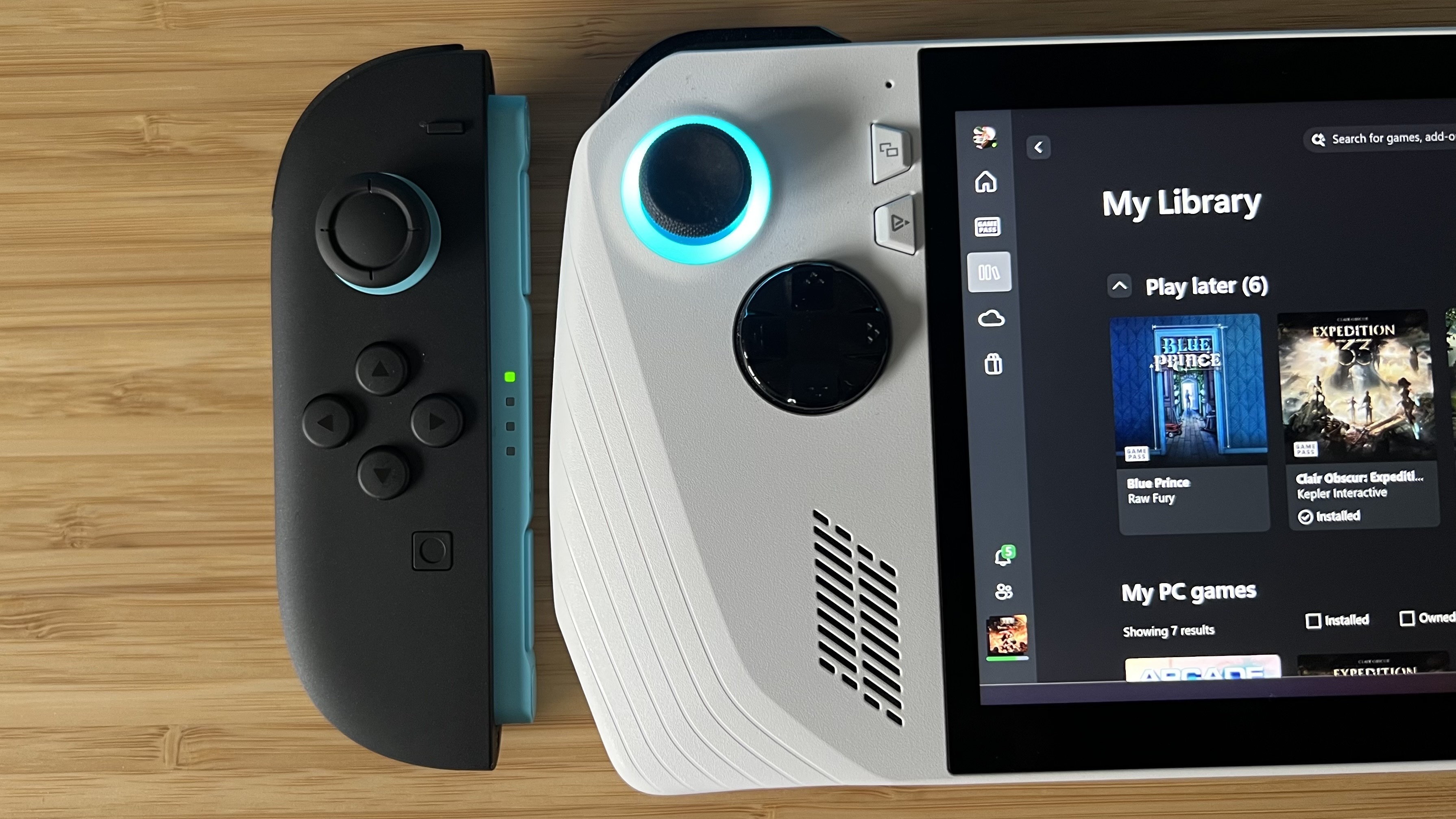
There's a battle here between functionality and quality. The Nintendo Switch 2 can do more, but the Asus ROG Ally feels much better doing less. I'm far more precise with my aiming and movement when using Asus's taller thumbsticks (and even better on the X where they feel much tighter), and directional inputs are more comfortable with the full d-pad.
No, you can't remove one side of it and use it as a pointer but the Asus ROG Ally can easily connect to any wireless gaming mouse you've got for a, potentially, much better experience instead.
At the end of the day, I prefer Asus's controls for single-player adventures and online multiplayer. They're more comfortable and more precise at the same time. However, if you know you're going to be prioritizing couch co-op gameplay the additional features of the Joy-Con 2 will prevail.
Winner: Asus ROG Ally
Connections
Nintendo Switch 2 | Asus ROG Ally Z1E | Asus ROG Ally X |
|---|---|---|
2x USB-C | 1x USB-C | 2x USB-C |
3.5mm audio | 3.5mm audio | 3.5mm audio |
No eGPU compatibility | ROG XG Mobile eGPU port | No ROG XG Mobile eGPU port |
Bluetooth | Bluetooth | Bluetooth |
Wi-Fi 6 | WiFi 6E | WiFi 6E |
The Nintendo Switch 2 and Asus ROG Ally X both have two USB-C ports, perfect for those who use wireless accessories via 2.4GHz receivers and still want to keep their handhelds plugged in. The regular Ally Z1E, however, only has one USB-C connection.
That's the only major difference between the two handhelds' port selections. The Asus ROG Ally does feature a proprietary connection for its own XG Mobile eGPU hub, but that's an incredibly expensive add-on that very few will be looking to purchase. If you've got an extra few grand to play with, though, you can add RTX 4090-level performance to your Ally via this port.
The Switch 2's second USB-C port clinches this one.
Winner: Nintendo Switch 2
Games
Nintendo Switch 2 | Asus ROG Ally Z1E | Asus ROG Ally X |
|---|---|---|
Nintendo Switch 2 Exclusive games | No exclusives | No exclusives |
Backwards compatible with Switch catalog (mostly) | No Switch compatibility | No Switch compatibility |
Locked to Nintendo eShop | Games available via any launcher | Games available via any launcher |
Physical games available | Download only | Download only |
Settle in, this is a complicated one.
The Nintendo Switch 2 is far more powerful than its predecessor, which means more demanding games like Cyberpunk 2077 and Borderlands 4 are coming to the system. That opens the Switch library considerably, blockbuster releases have a much higher chance of also landing on the Switch 2 than they did the original model. Not only that, but you will only be able to play first-party (and some third-party) Nintendo Switch games on the system itself - Ninty is hard on its own exclusivity.
That leaves the Asus ROG Ally in an interesting position. This is a full Windows PC, so you can run anything you could on a laptop or desktop on here (in theory). That's a much bigger library, pretty much everything (outside of those aforementioned exclusives, as well as those of the PS5) can be played on this device in some form.
You're also not beholden to one eShop here. Rather than living by Nintendo's prices, you can shop around between Steam, Epic, and other launchers.
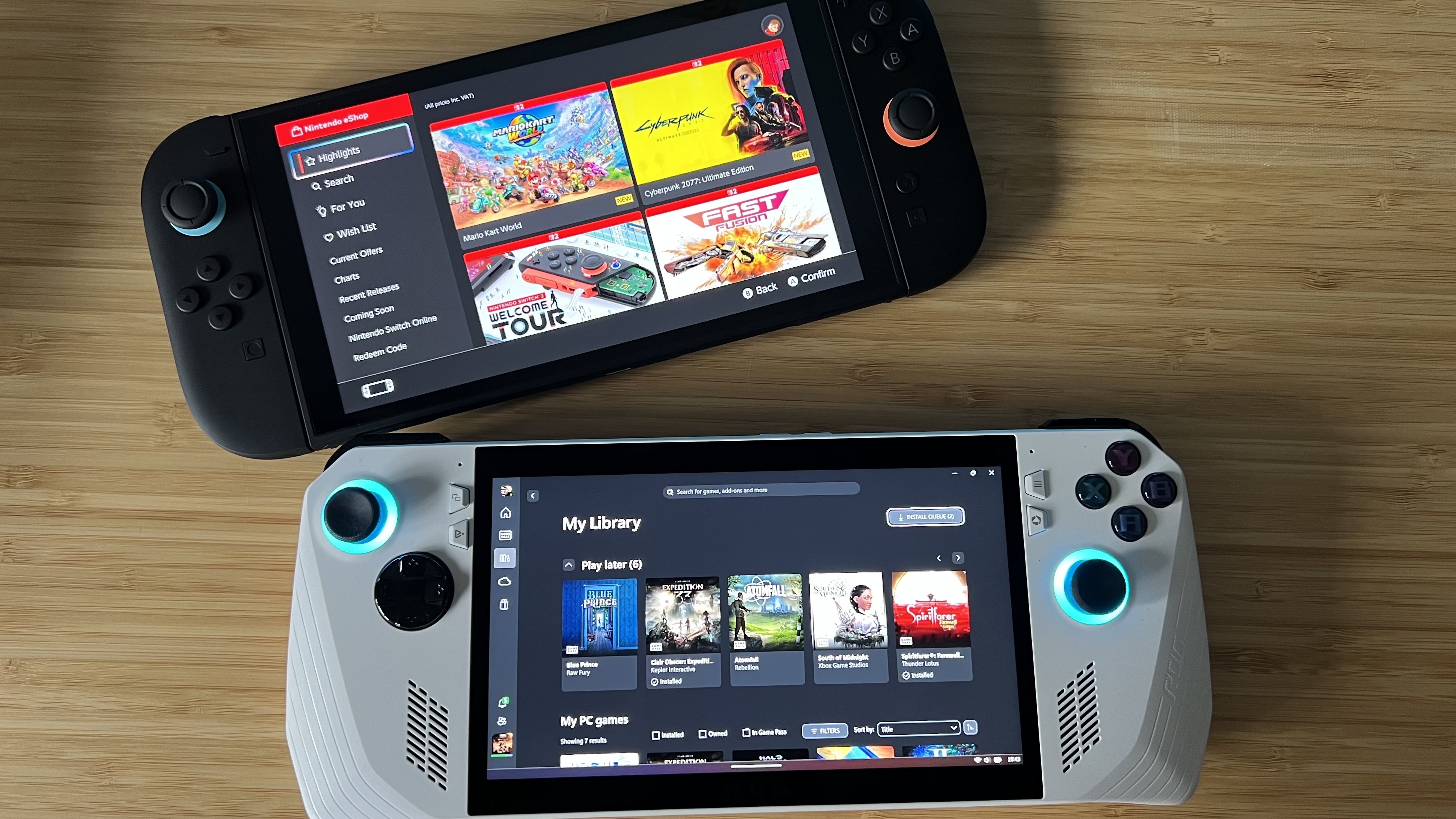
Similarly, the ROG Ally has one final trick up its sleeve; Game Pass. Love it or hate it, Microsoft's subscription service is the best-value way to play new and old releases if you're not building a physical collection. A massive catalog of blockbusters and a healthy roster of day one releases means this is a fantastic tool in the arsenal of any Asus ROG Ally owner.
If you're a Nintendo fan you'll want to prioritize those first-party exclusives, if you're a gaming fan looking for one device to play a much wider range of releases, the Asus ROG Ally is a much better pick. The Switch 2 is promising better Triple-A compatibility, but nothing is concrete until it's out on the digital shelves.
For a better picture of the difference between the platforms, I've collected every game featured in this year's The Game Awards nominations and compared platform availability between the two. Compatibility is only ticked if there is an officially confirmed version of the game heading to Nintendo Switch 2.
Expand full game list ↓
| Header Cell - Column 0 | Nintendo Switch 2 | Asus ROG Ally |
|---|---|---|
Astro Bot | ❌ | ❌ |
Balatro | ✅ | ✅ |
Black Myth: Wukong | ❌ | ✅ |
Elden Ring: Shadow of the Erdtree | ✅ | ✅ |
Final Fantasy VII Rebirth | ❌ | ✅ |
Metaphor: Refantazio | ❌ | ✅ |
Like a Dragon: Infinite Wealth | ❌ | ✅ |
Senua's Saga: Hellblade II | ❌ | ✅ |
Silent Hill 2 | ❌ | ✅ |
Neva | ✅ | ✅ |
Stellar Blade | ❌ | ✅ |
Call of Duty Black Ops 6 | ❌ | ✅ |
Life is Strange: Double Exposure | ✅ | ✅ |
Star Wars Outlaws | ✅ | ✅ |
Diablo IV | ❌ | ✅ |
Dragon Age: The Veilguard | ❌ | ✅ |
Prince of Persia: The Lost Crown | ✅ | ✅ |
Closer the Distance | ❌ | ✅ |
Indika | ❌ | ✅ |
Tales of Kenzera: Zau | ✅ | ✅ |
Destiny 2 | ❌ | ✅ |
Final Fantasy XIV | ❌ | ✅ |
Fortnite | ✅ | ✅ |
Helldivers 2 | ❌ | ✅ |
Baldur's Gate 3 | ❌ | ✅ |
No Man's Sky | ✅ | ✅ |
Animal Well | ✅ | ✅ |
Lorelei and the Laser Eyes | ✅ | ✅ |
UFO 50 | ❌ | ✅ |
Manor Lords | ❌ | ✅ |
Pacific Drive | ❌ | ✅ |
The Plucky Squire | ✅ | ✅ |
Warhammer 40,000: Space Marine 2 | ❌ | ✅ |
The Legend of Zelda: Echoes of Wisdom | ✅ | ❌ |
Dragon's Dogma 2 | ❌ | ✅ |
Dragon Ball: Sparking Zero | ❌ | ✅ |
Granblue Fantasy Versus: Rising | ❌ | ✅ |
Marvel vs Capcom Fighting Collection: Arcade Classics | ✅ | ✅ |
Multiversus | ❌ | ✅ |
Tekken 8 | ❌ | ✅ |
Princess Peach: Showtime! | ✅ | ❌ |
Super Mario Party Jamboree | ✅ | ❌ |
Age of Mythology: Retold | ❌ | ✅ |
Frostpunk 2 | ❌ | ✅ |
Kunitsu-Gami: Path of the Goddess | ✅ | ✅ |
Unicorn Overlord | ✅ | ❌ |
F1 24 | ❌ | ✅ |
EA Sports FC 25 | ✅ | ✅ |
NBA 2K25 | ✅ | ✅ |
Top Spin 2K25 | ❌ | ✅ |
WWE 2K24 | ❌ | ✅ |
Death Stranding 2: On the Beach | ❌ | ❌ |
Ghost of Yotei | ❌ | ❌ |
Grand Theft Auto 6 | ❌ | ❌ |
Metroid Prime 4: Beyond | ✅ | ❌ |
Monster Hunter Wilds | ❌ | ✅ |
Counter-Strike 2 | ❌ | ✅ |
DOTA 2 | ❌ | ✅ |
League of Legends | ❌ | ✅ |
Mobile Legends: Bang Bang | ❌ | ❌ |
Valorant | ❌ | ✅ |
Winner: Asus ROG Ally
Performance
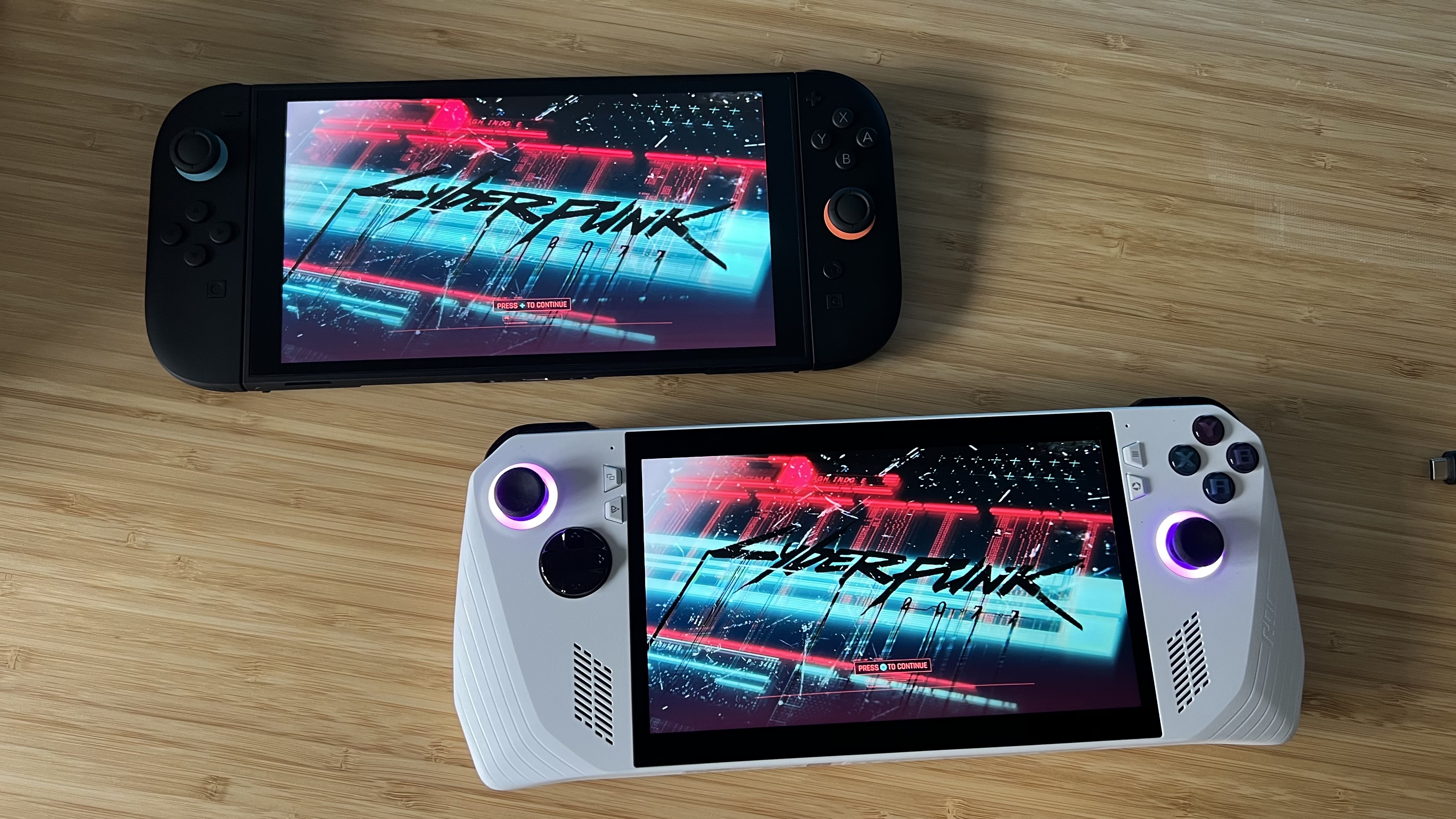
The Asus ROG Ally is a PC, but it's not going to give you conventional PC performance. Yes, it's an efficient system and it's run nearly every game I've tried on it comfortably (the ROG Ally X is a particularly potent beast), but there are more steps to getting that frame-perfect experience.
The Nintendo Switch 2 picks up its new resolution and sprints with it. This is a seriously impressive achievement considering the size of the device and while the final result isn't quite as texturally sound as you'll see in lower resolutions on the Ally it's still a smooth, enjoyable experience.
The Asus ROG Ally can run in 4K, but it generally prefers not to. The X model is far better suited to this kind of high-resolution gaming, with its boosted RAM, but you're still restricted to lighter games. Cyberpunk 2077 could never.
Nintendo is running a custom Nvidia chip inside its new handheld, whereas the Asus ROG Ally is a full AMD build. The performance of that Z1 Extreme chip puts it at the top of the current handheld PC market, out-gunning cheaper options like the Steam Deck easily.
It's likely that Nintendo is relying on Nvidia's own DLSS upscaling tech to keep its 4K 120fps promise, whereas the Asus ROG Ally uses AMD's FSR kit. Both a similar in their framerate-boosting capabilities, but both also leave behind their own visual defects from time to time.
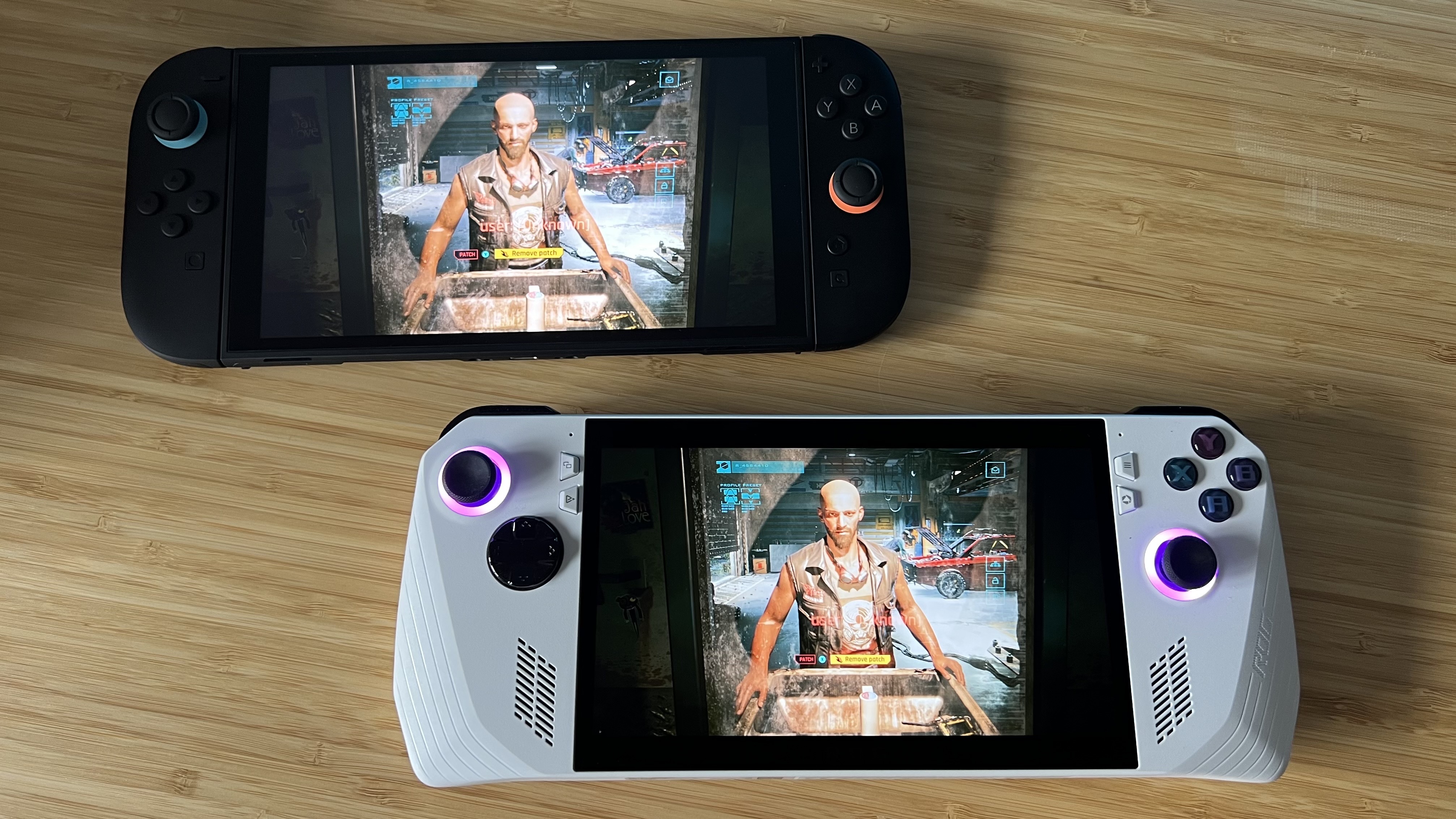
In my testing of Cyberpunk 2077 so far, the Asus ROG Ally and Nintendo Switch 2 have played to different strengths. The Switch is much smoother, with no screen tearing and very very few judders. Textures and lighting are generally similar between the two, with both taking a heavy drop during faster gameplay moments. However, the Ally has a crisper level of detail on its visuals than the Switch 2 - most notable around character faces. That's running the Asus ROG Ally on Steam Deck graphical settings, things are a lot choppier once you start moving into full RT offerings.
The Asus ROG Ally is capable of more than the Nintendo Switch 2 is, but you'll need to jump through more hoops to get there. That could even things up, if it weren't for the Asus ROG Ally X. With a massive 24GB of faster 7500MHz RAM, this is where true framerate chasers need to be looking.
Winner: Asus ROG Ally X
Storage
Nintendo Switch 2 | Asus ROG Ally Z1E | Asus ROG Ally X |
|---|---|---|
256GB internal storage | 512GB PCle 4.0 NVMe M.2 SSD | 1TB PCle 4.0 NVMe M.2 SSD |
Additional storage up to 2TB (MicroSD Express) | Additional storage up to 2TB (MicroSD), upgradeable with 2230 M.2 NVMe drives | Additional storage up to 2TB (MicroSD), upgradeable with 2280 M.2 NVMe drives |
The Nintendo Switch 2 has seen a massive increase in storage this generation, upping the Switch OLED's 64GB to an excellent 256GB starting position. That's still half of the 512GB SSD inside the Asus ROG Ally, though, and a quarter of the 1TB Ally X. Those numbers aren't to be taken at face value, though, the runway you've actually got from those drives differs.
That's because game sizes are on the up. While original Switch games may have taken up a few gigabytes, Cyberpunk 2077 will require around 60GB of space. As Nintendo starts taking on these chunkier games, the Switch 2's built in storage is going to suffer just as much as its predecessor did. These are PC-sized game files, and even the Asus ROG Ally struggles with double the space.
Both devices are upgradeable, with the Switch 2 only accepting MicroSD Express cards and the Ally offering a swappable internal SSD and extra storage via a MicroSD as well. While it's a big leap in sheer size, Asus still wins this competition.
Winner: Asus ROG Ally
Nintendo Switch 2 vs Asus ROG Ally: which should you buy?
Nintendo wins out in price, portability, display, and connections, while Asus takes the lead in comfort, battery, controls, games, storage, and overall performance. That doesn't mean everyone should be flocking to the Ally, though.
The console experience is still very different to that of a PC, even in 2025. Driver patches, graphical settings, and varying system compatibility among games mean handheld PCs are still far from the slick, streamlined experiences of a purpose-built operating system. The Nintendo Switch 2 is much more pleasant to use outside of actual gaming. You know the games you buy will run, you don't have to dig through updates and settings menus to get them going perfectly.
If you're buying for younger kids or you simply want fewer barriers between you and your games, the Nintendo Switch 2 is the better buy. If you're looking to play all the latest and greatest games on one portable device, though, Asus is still going to be your best friend.
Buy the Nintendo Switch 2 if:
✅ You want to play first-party Nintendo games
✅ You don't want to worry about settings and updates
✅ You don't mind waiting for newer third-party releases
✅ You regularly play couch co-op multiplayer
Buy the Asus ROG Ally if:
✅ You want access to as more games
✅ You want a full-sized control scheme
✅ You want a chunkier grip
You can find out exactly where to buy Nintendo Switch 2 with our launch day live reporting, or check out the best Nintendo Switch 2 MicroSD Express cards available now. I've also been refereeing the Nintendo Switch 2 vs Nintendo Switch OLED battle as well.

Managing Editor of Hardware at GamesRadar+, I originally landed in hardware at our sister site TechRadar before moving over to GamesRadar. In between, I've written for Tom’s Guide, Wireframe, The Indie Game Website and That Video Game Blog, covering everything from the PS5 launch to the Apple Pencil. Now, i'm focused on Nintendo Switch, gaming laptops (and the keyboards, headsets and mice that come with them), PS5, and trying to find the perfect projector.
You must confirm your public display name before commenting
Please logout and then login again, you will then be prompted to enter your display name.



